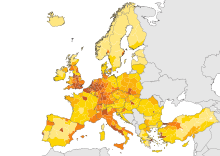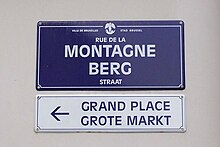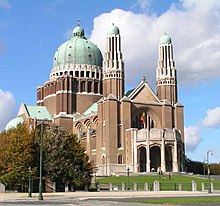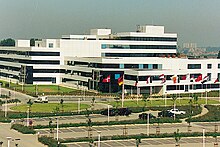Under the
Köppen climate classification, Brussels experiences an
oceanic climate (Cfb). Brussels' proximity to coastal areas influences the area's climate by sending marine air masses from the
Atlantic Ocean.
Nearby wetlands also ensure a maritime temperate climate. On average
(based on measurements over the last 100 years), there are approximately
200 days of rain per year in the Brussels-Capital Region, the highest
amount of any European capital.
[54] Snowfall is infrequent, averaging 24 days per year. In Brussels there are often violent thunderstorms.
| [hide]Climate data for Brussels |
| Month |
Jan |
Feb |
Mar |
Apr |
May |
Jun |
Jul |
Aug |
Sep |
Oct |
Nov |
Dec |
Year |
| Record high °C (°F) |
15.3
(59.5) |
20.0
(68) |
24.2
(75.6) |
28.7
(83.7) |
34.1
(93.4) |
38.8
(101.8) |
37.1
(98.8) |
36.5
(97.7) |
34.9
(94.8) |
27.8
(82) |
20.6
(69.1) |
16.7
(62.1) |
38.8
(101.8) |
| Average high °C (°F) |
5.7
(42.3) |
6.6
(43.9) |
10.4
(50.7) |
14.2
(57.6) |
18.1
(64.6) |
20.6
(69.1) |
23.0
(73.4) |
22.6
(72.7) |
19.0
(66.2) |
14.7
(58.5) |
9.5
(49.1) |
6.1
(43) |
14.2
(57.6) |
| Daily mean °C (°F) |
3.3
(37.9) |
3.7
(38.7) |
6.8
(44.2) |
9.8
(49.6) |
13.6
(56.5) |
16.2
(61.2) |
18.4
(65.1) |
18.0
(64.4) |
14.9
(58.8) |
11.1
(52) |
6.8
(44.2) |
3.9
(39) |
10.54
(50.97) |
| Average low °C (°F) |
0.7
(33.3) |
0.7
(33.3) |
3.1
(37.6) |
5.3
(41.5) |
9.2
(48.6) |
11.9
(53.4) |
14.0
(57.2) |
13.6
(56.5) |
10.9
(51.6) |
7.8
(46) |
4.1
(39.4) |
1.6
(34.9) |
6.9
(44.4) |
| Record low °C (°F) |
−21.1
(−6) |
−18.3
(−0.9) |
−13.6
(7.5) |
−5.7
(21.7) |
−2.2
(28) |
0.3
(32.5) |
4.4
(39.9) |
3.9
(39) |
0.0
(32) |
−6.8
(19.8) |
−12.8
(9) |
−17.7
(0.1) |
−21.1
(−6) |
| Average precipitation mm (inches) |
76.1
(2.996) |
63.1
(2.484) |
70.0
(2.756) |
51.3
(2.02) |
66.5
(2.618) |
71.8
(2.827) |
73.5
(2.894) |
79.3
(3.122) |
68.9
(2.713) |
74.5
(2.933) |
76.4
(3.008) |
81.0
(3.189) |
852.4
(33.559) |
| Average precipitation days |
19.2 |
16.3 |
17.8 |
15.9 |
16.2 |
15.0 |
14.3 |
14.5 |
15.7 |
16.6 |
18.8 |
19.3 |
199 |
| Average snowy days |
5.2 |
5.9 |
3.2 |
2.4 |
0 |
0 |
0 |
0 |
0 |
0 |
2.4 |
4.6 |
24.1 |
| Average relative humidity (%) |
86.6 |
82.5 |
78.5 |
72.5 |
73.2 |
74.1 |
74.3 |
75.5 |
80.9 |
84.6 |
88.2 |
88.8 |
80 |
| Mean monthly sunshine hours |
59 |
77 |
114 |
159 |
191 |
188 |
201 |
190 |
143 |
113 |
66 |
45 |
1,546 |
| Source: KMI/IRM[55] |
Demographics
Population
Brussels is located in one of the most
urbanised regions of Europe, between
Paris,
London,
Rhine-Ruhr, and the
Randstad.
The Brussels-Capital Region has a population of around 1.2 million and
has witnessed in recent years a remarkable increase in its population.
In general, the population of Brussels is younger than the national
average and the gap between rich and poor is wider.
[56]
|
01-07-2004[57] |
01-07-2005[57] |
01-07-2006[57] |
01-01-2008[57] |
01-01-2015[57] |
| Brussels-Capital Region[57] |
1.004.239 |
1.012.258 |
1.024.492 |
1.048.491 |
1.181.272 |
| -- of which foreigners[57] |
262.943 |
268.009 |
277.682 |
295.043 |
385.381 |
Nationalities
| Largest groups of foreign residents[58] |
| Nationality |
Population (2016) |
 France France |
62,507 |
 Romania Romania |
38,690 |
 Morocco Morocco |
38,274 |
 Italy Italy |
32,322 |
 Spain Spain |
28,042 |
 Poland Poland |
26,399 |
 Portugal Portugal |
19,791 |
 Bulgaria Bulgaria |
11,371 |
 Germany Germany |
10,527 |
 Democratic Republic of the Congo Democratic Republic of the Congo |
8,846 |
Brussels is home to a large number of immigrants. At the last Belgian
census in 1991, 63.7% of inhabitants in Brussels-Capital Region
answered that they were Belgian citizens, born as such in Belgium.
However, there have been numerous individual or familial migrations
towards Brussels since the end of the 18th century, including political
refugees (
Karl Marx,
Victor Hugo,
Pierre Joseph Proudhon,
Léon Daudet
for example), from neighbouring or more distant countries as well as
labour migrants, former foreign students or expatriates, and many
Belgian families in Brussels can claim at least one foreign grandparent.
Brussels has a large concentration of immigrants and their children
from other countries, including many of Turkish and Moroccan ancestry,
together with French-speaking black Africans from the
Democratic Republic of the Congo,
Rwanda and
Burundi.
People of foreign origin make up nearly 70%
[59]
of the population of Brussels, most of whom have been naturalized
following the great 1991 reform of the naturalization process. About 32%
of city residents are of non-Belgian
European origin, and 36% are of another background, mostly from
Morocco,
Turkey and Sub-Saharan
Africa. Among all major migrant groups from outside the EU, a majority of the permanent residents have acquired Belgian nationality.
[60]
Languages
Estimate of languages spoken at home (Capital Region, 2013)
[61]
French
Dutch and French
Dutch
French and other language
Neither Dutch nor French
Since the founding of the
Kingdom of Belgium in 1830, Brussels has transformed from being almost entirely
Dutch-speaking (
Brabantian dialect to be exact), to being a multilingual city with French (specifically
Belgian French) as the majority language and
lingua franca. This language shift, the
Francization of Brussels, is rooted in the 18th century and accelerated after
Belgium became
independent and Brussels expanded past its original boundaries.
[62][63]
French-speaking immigration contributed to the Frenchification of
Brussels; both Walloons and expatriates from other countries, mainly
France, came to Brussels in great numbers. However, a more important
cause for the Frenchification was the language change over several
generations from Dutch to French that was performed in Brussels by the
Flemish people
themselves. The main reason for this was the political, administrative
and social pressure, partly based on the low social prestige of the
Dutch language in Belgium at the time; this made French the only
language of administration, law, politics and education in Belgium and
thus necessary for social mobility.
[64]
From 1880 on, faced with the necessity of using French in dealing with
such institutions, more and more Dutch-speakers became bilingual, and a
rise in the number of monolingual French-speakers was seen after 1910.
Halfway through the 20th century the number of monolingual
French-speakers surpassed the number of mostly bilingual Flemish
inhabitants.
[65]
Only since the 1960s, after the fixation of the Belgian
language border, and after the socio-economic development of Flanders was in full effect, could Dutch stem the tide of increasing French use.
[66]
Through immigration, a further number of formerly Dutch-speaking
municipalities in surrounding Brussels became majority French-speaking
in the second half of the 20th century.
[67][68][69] This phenomenon is, together with the future of Brussels, one of the most controversial topics in all of
Belgian politics.
[70][71]
Bilingual signs in Brussels
Given its Dutch-speaking origins and the role that Brussels plays as
the capital city in a bilingual country, the administration of the
entire Brussels-Capital Region is fully bilingual, including its
subdivisions and public services. Nevertheless, some communautarian
issues remain. Flemish political parties demanded for decades that the
Flemish part of
Brussels-Halle-Vilvoorde
arrondissement be separated from the Brussels Region (which made
Halle-Vilvoorde a monolingual Flemish arrondissement). BHV was divided
mid 2012. The French-speaking population regards the language border as
artificial
[72] and demands the extension of the bilingual region to at least all six
municipalities with language facilities in the surroundings of Brussels.
[73] Flemish politicians have strongly rejected these proposals.
[74][75][76]
The original Dutch dialect of Brussels (
Brussels) is a form of
Brabantic (the variant of Dutch spoken in the ancient
Duchy of Brabant) with a significant number of loanwords from French, and still survives among a minority of inhabitants called
Brusseleers,
many of them quite bi- and multilingual, or educated in French and not
writing in Dutch. Brussels and its suburbs have evolved from a
Dutch-dialect–speaking town to a mainly French-speaking town. The ethnic
and national self-identification of the inhabitants is quite different
along ethnic lines.
For their French-speaking
Bruxellois, it can vary from Belgian, Francophone Belgian,
Bruxellois (like the Memellanders in interwar ethnic censuses in
Memel),
Walloon
(for people who migrated from the Wallonia Region at an adult age); for
Flemings living in Brussels it is mainly either Flemish or
Brusselaar (Dutch for an inhabitant) and often both. For the
Brusseleers,
many simply consider themselves as belonging to Brussels. For the many
rather recent immigrants from other countries, the identification also
includes all the national origins: people tend to call themselves
Moroccans or Turks rather than an American-style hyphenated version.
The two largest foreign groups come from two
francophone countries: France and
Morocco.
[77] The first language of roughly half of the inhabitants is not an official one of the Capital Region.
[78] Nevertheless, about three out of four residents are Belgian nationals.
[79][80][81]
In recent decades, owing to migration and the city's international
role, Brussels is home to a growing number of foreign language speakers.
In 2013, figures cited in the Marnix Plan show that 63.2% of Brussels
inhabitants are native speakers of French, while less than 20% are
native Dutch speakers. Just 2.5% speak English as their mother tongue,
but 29.7% of people living in the city claim to speak English well or
very well.
[82]
Even though some people want English to be used as an unofficial
compromise language between Dutch and French, French remains the lingua
franca. And laws still require Dutch and French translations in most
cases. The acceptance of English as a language for communication with
the city's public servants depends entirely on the knowledge of this
language by the public servants, though they must accept questions in
French and Dutch.
[83]
The migrant communities, as well as rapidly growing communities of
EU-nationals from other EU-member states, speak many languages like
French,
Turkish,
Arabic,
Berber,
Spanish,
Italian,
Portuguese,
Polish,
German, and (increasingly)
English. The degree of linguistic integration varies widely within each migrant group.
Religions
Although historically majority
Roman Catholic,
especially since the expulsion of Protestants in the 16th century, most
residents of Brussels are nonreligious, with only about 10% of
Catholics regularly attending church services. In reflection of its
multicultural makeup, it hosts a variety of religious communities, as
well as large numbers of
atheists and
agnostics. Minority faiths include
Islam,
Anglicanism,
Eastern Orthodoxy,
Judaism, and
Buddhism.
Recognized religions and
Laïcité
enjoy public funding and school courses: every pupil in an official
school from 6 years old to 18 must choose 2 hours per week of compulsory
religion – or
Laïcité – inspired morals.
[citation needed]
Brussels has a large concentration of
Muslims,
mostly of Turkish and Moroccan ancestry. Belgium does not collect
statistics by ethnic background, so exact figures are unknown. It was
estimated that in 2005 people of Muslim background living in the
Brussels Region numbered 256,220 and accounted for 25.5% of the city's
population, a much higher concentration than those of the other regions
of Belgium.
[84][better source needed]
| Regions of Belgium[84] (1 January 2005) |
Total population |
People of Muslim origin |
% of Muslims |
| Belgium |
11,371,928 |
781,887 |
6.9% |
| Brussels-Capital Region |
1 180 531 |
306,938 |
25% |
| Wallonia |
3,395,942 |
136,596 |
4.0% |
| Flanders |
6,043,161 |
235,935 |
3.9% |























